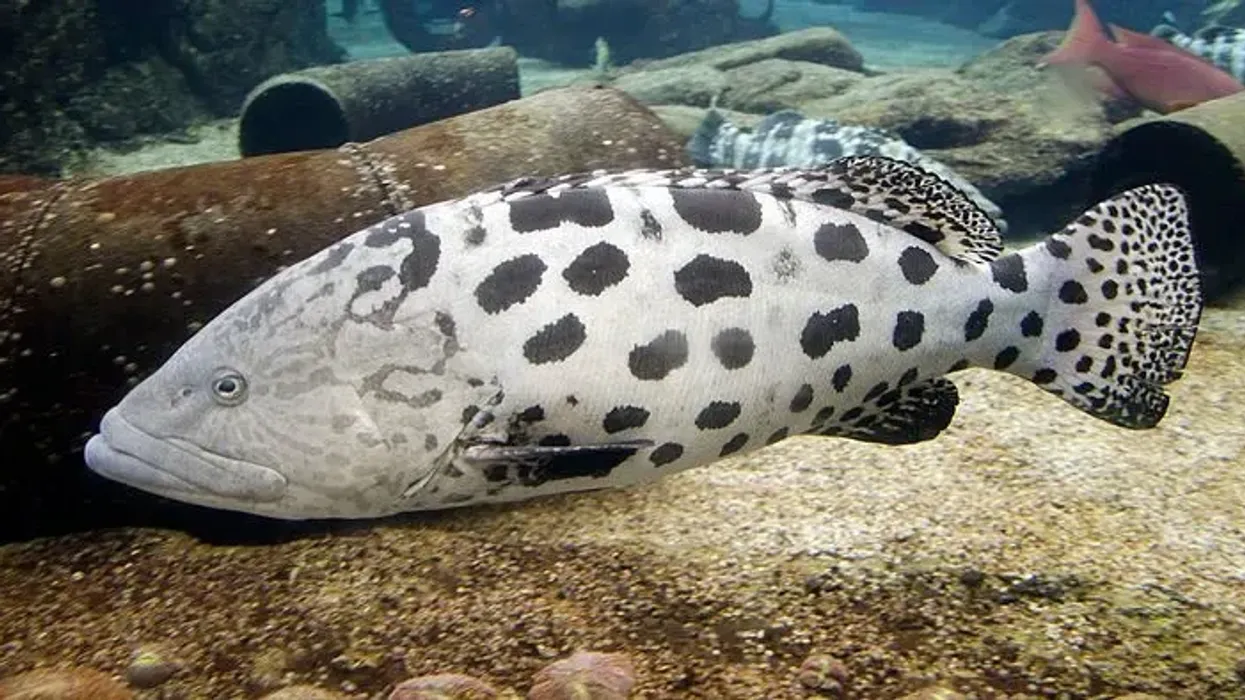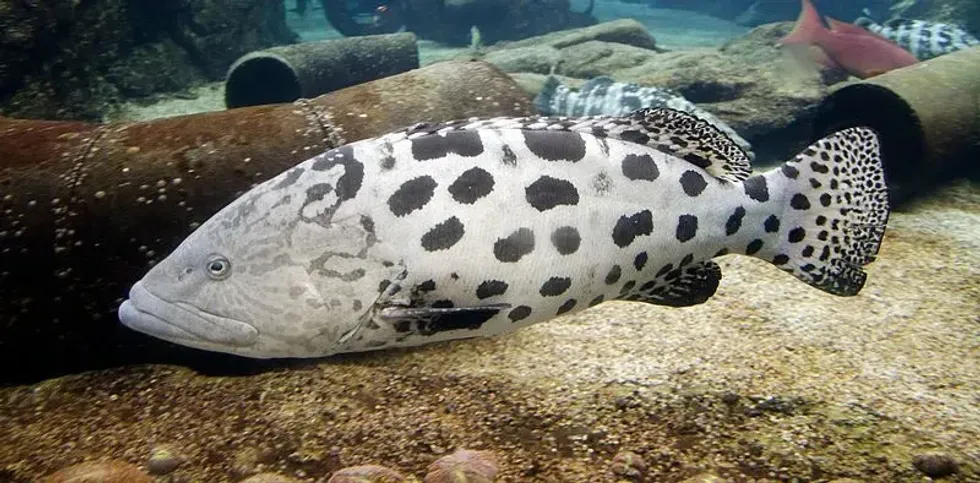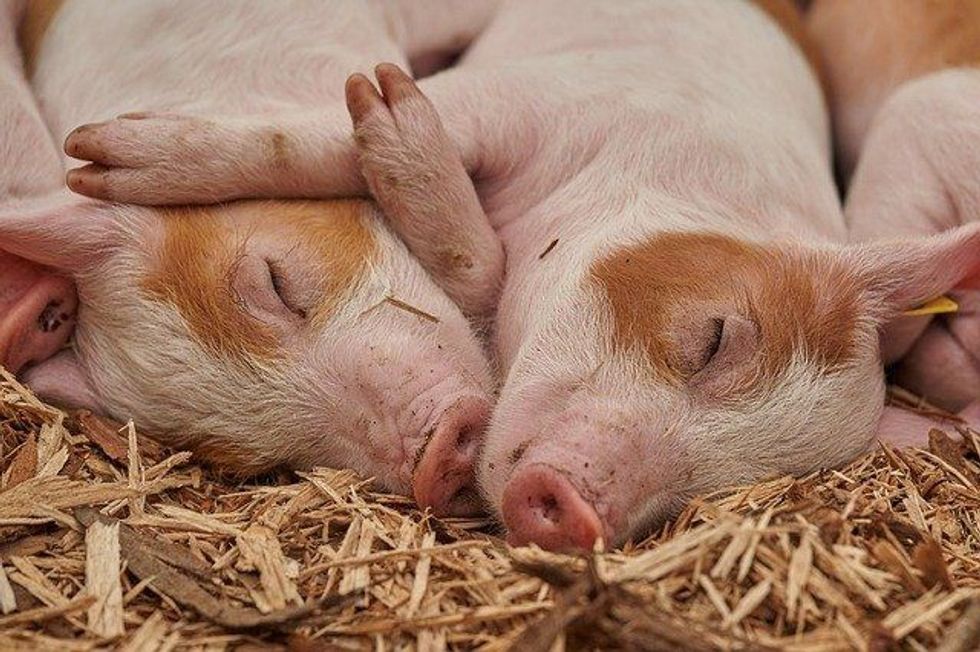A potato grouper is a marine species with straight dorsal head from Serranide family. The distribution is in far wide Indo-Pacific ocean and Red sea region. It is even located in the Great barrier reef of Australia and eastern coast of Africa.
Its weight is 240 lb (108.9 kg) and is 78.7 in (200 cm) in length. It has pale brownish-gray in color description and widely spread dark brown blotches. They reach sexual maturity at the age of 12 years.
They feed on large fishes, invertebrates, and small sharks. Potato bass do not bite or chew their prey, only swallow it. They dive to deep depth for hunting.
The weight and length size of potato grouper is less than the giant grouper. This cod produces a loud rumbling sound which often scares the scuba divers. They are territorial in nature.
If you enjoy reading about the magpie-lark, do check out interesting facts about the Nassau grouper and strawberry grouper.
Potato Grouper Interesting Facts
What type of animal is a potato grouper?
A potato grouper (Epinephelus tukula) is a marine species of Serranidae family.
What class of animal does a potato grouper belong to?
Epinephelus tukula is a type of fish from Epinephelus genus.
How many potato groupers are there in the world?
The exact number of Epinephelus tukula are unknown. But they are abundant in nature.
Where does a potato grouper live?
There is a wide distribution of potato grouper (Epinephelus tukula) in the Indo-Pacific oceans. There is a high concentration of these birds along the eastern coast of Africa from the Red Sea to KwaZulu-Natal.
It is also found east to the Pacific and extends into the Pacific where it reaches the Solomon Islands as far east as Australia, north to south of Japan, and south to Australia.
The potato grouper fish is native to northern Australia, and is found from Shark Bay near Western Australia along the coast to Moreton Bay near Queensland. The Great Barrier Reef contains this species as well.
What is a potato grouper's habitat?
In coral reefs, the potato cod grouper fish lives in channels within the reefs and around seamounts in areas where the currents are strong. Adults usually dive at depth of range 33-492 ft (10-150 m). Juveniles are often found at tidal pools on the reef.
Who do potato groupers live with?
A cod family Serranidae is a solitary fish and usually stays in its range. It is territorial in nature.
How long does a potato grouper live?
A cod live for an average of 37 years, but some members of this fish is believed to be able to live to the age of 100.
How do they reproduce?
Potato basses have a very fascinating method of reproduction that is referred to as broadcast spawning. What they do is congregate at a spawning location which a grouper may travel miles to reach.
In groups of about 100 fish, males release their sperm at the same time as females release their brown spotted eggs into a water column that stands above a relatively deep reef. They ensure that the eggs fertilize, and since these fertilized eggs descend into the deep reef, they are not threatened by predators.
What is their conservation status?
These are abundant in shallow reefs of Indo-Pacific ocean and are listed as the Least Concern under the IUCN Red List of endangered species.
Potato Grouper Fun Facts
What do potato groupers look like?
As a large and robust species, this potato bass grows up to the range of 78.7 in (200 cm) in length and has a weight of 240 lb (108.9 kg). According to the description of its dorsal profile of its head, it is straight, with convex edges between its eyes.
A preopercle is round or subangular in shape, while a gill cover has straight lines at the top. Typical dorsal fins have 11 spines and 14-15 soft rays, while anal fins have three spines and eight soft rays.
A pale brownish-grey color covers this species, which is covered with large dark blotches which are widely spaced.
The fins are punctured by small dark spots and black lines radiate from the eyes. A common name for potato bass is the potato patch because of its dark brown spots resembling potatoes.
Sea basses can reach lengths of between 2.9 and 3.5 times its depth. They are known by many different names like black-spotted rockcod, brown-marbled grouper, brown-marbled reefcod, Cod, Hind, Potato Bass, Trout.

How cute are they?
The potato grouper (Epinephelus tukula) are not cute at all. As a matter of fact, facing this cod fish in the water would be rather intimidating on account of its length, weight and appearance. They are ambush predators.
How do they communicate?
In order to communicate, these sea basses produce rumbling sounds that travel through the water with their mouths that nearby scuba divers feel like a sonic boom effect. As well as for communication with the other species of its kind, potato bass also does this to protect its own territory due to their territorial nature.
How big is a potato grouper?
The potato grouper size is 78.7 in (200 cm) in length. It is smaller than the giant grouper. They reach sexual maturity at approximately 12 years of age. Its length is a bit bigger than an average human.
How fast can a potato grouper swim?
It is not known what the average speed of this cod fish is, but it has been recorded to reach a speed range of 78 mph (125.5 kph).
How much does a potato grouper weigh?
A potato cod has the weight of about 240 lb (108.9 kg).
What are the male and female names of the species?
There aren’t any specific names for the males and females of this species. Males are referred to as male potato groupers while females are referred to as female potato groupers.
What would you call a baby potato grouper?
Cod juveniles are normally called juveniles until they reach the age of five, at which point they are considered adults.
What do they eat?
Cods are carnivores. The hunt usually takes place at dusk near the bottom and dive to deep depth. The diet of cod includes large fishes, invertebrates, rays, crabs, squid, lobsters, octopuses, and small sharks.
Are they dangerous?
In spite of the fact that these heavy-bodied fish do not eat humans, cods are capable of attacking humans if threatened.
Would they make a good pet?
You would not want to keep the potato cod as a pet. Carnivorous fishes, such as these, exhibit high levels of predatory behavior. They should be allowed to live in their natural habitat along the reef of the ocean, where they can hunt for food alongside the other sea creatures.
Did you know...
The cod does not bite or chew its prey. Because their oral cavity and opening are large, they consume it whole. The cod is also known for swimming for long distances, just as other species of groupers do.
Cod specimens have been induced to change sex from female to male, so they might be protogynous hermaphrodites like other groupers.
Is potato grouper edible?
Potato grouper fishing allows many locals to enjoy this delicious fillets. The cod has a firm texture, white meat and large flakes. The flavor is distinct, yet mild.
Nutritionally and aesthetically, it is excellent. There are many ways to cook grouper, including grilling, frying, sautéing, poaching, baking, and steaming. With oil, butter, ginger, lemon juice, salt, and pepper, bake it for about 5-7 minutes in a baking dish and there you go!
Why is it called potato grouper?
Morgans of the East African Fisheries Research Organization first described the potato cod in 1953 at Zanzibar with Mafia Island in Tanzania given as its type locality.
Here at Kidadl, we have carefully created lots of interesting family-friendly animal facts for everyone to discover! For more relatable content, check out these giant grouper facts and red grouper facts pages.
You can even occupy yourself at home by coloring in one of our free printable grouper coloring pages.
Main image and second image by Amada44.









